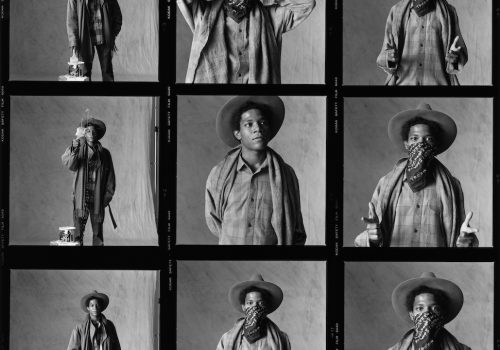Galerie Patrick Gutknecht presents a set of never-before-seen portraits of Jean-Michel Basquiat, made in 1983 in Tokyo by Japanese photographer Yutaka Sakano. Two years after the American recognition of his work, during a trip by Jean-Michel Basquiat to Tokyo, Yutaka Sakano spends a day in the studio with the young artist for a fashion show commissioned by a Japanese designer.
The session was shot over a single day. It is so short.
And when one discovers these images one finds there nevertheless all the richness and the generosity of a professional and the personal implication: one feels there the joy, the complicity, the dynamism, the game and the pleasure. The prints are silver prints made in Japan.
“One day in July 1983, I received a phone call from Midori Kitamura, Issey Miyake’s assistant who was in charge of press relations at the time. She tells me that a young artist named Basquiat, who has become a sensation in New York, was coming to Japan, and she asked me if I could photograph him for a men’s fashion magazine. I immediately reserve studio # 8 in the basement of Studio Azabu, which no longer exists today. The day of the shooting, I loaded in my car a hand made backdrop and went to the rendez-vous in a good mood. This is the first time I met Basquiat. I did not know anything about him. He looks like a wonderful young man. He takes the initiative during the shooting, improvising all kinds of poses. It is also the first time he meets me, and we did not speak each other language, having to opt instead for hand gestures communication. He did his best to comply with the guidelines given by the Japanese photographer that I am. Even though the photos are for color publication, I always take black and white photos for my own use. And if I find the subject particularly interesting, all the shooting is also done in B&W.
In the workshop, Basquiat finds a box of white paint used to paint the cyclorama. He dipped a brush and held it in front of his face, while splashing paint everywhere. This surprised everyone attending the scene. Whenever he repeated the movement, his leather jacket got a little more paint. After a while, Midori screamed her indignation, because with the exception of the jeans and moccasins he came with, all the clothes for the shoot were graciously loaned by Issey Miyake. His jeans and moccasins are already splashed with paint, with colors found in his paintings. He seemed to have jumped directly from his New York loft to the Tokyo studio.
I think I remember that Basquiat picked up objects he found in the studio and used them in a very personal and fascinating way for this shoot. At the time, 22 years old, Basquiat still had childish features and his smile reflected the mischievous look of youth. His art reflects the same pure and innocent spirit.
In the 1980s, I went to New York sometimes, either for work or for my own account. I was in my thirties and could at the time without problem spend all night in night clubs before a shooting the next day. In a Manhattan club, Keith Haring was close to me, dancing happily with pretty boys in a circle. The aspect of New York culture that struck me the first time was to see pictures nonchalantly exposed in a hallway of the Palladium nightclub. One of them was a flash photo of Andy Warhol, taken from the front down a steel staircase leading underground, and the expression on his face was unforgettable. Another showed an aerial shot of Fidel Castro giving a speech on a Cuban square with so many people crammed together that their heads looked like matchsticks. There were also other photos of rare intensity, exhibited quite casually.
The exuberance demonstrated by Basquiat in Tokyo seems to reflect the1983 year lived as a golden age for him. Overflowing with talent, Basquiat himself – and not only his paintings – had become a focal point in the art world. Taking photos, in a sense, is coping with death. To live is to die, and to die is to live. Leaving this world at the age of only 27, Basquiat achieved success and fame in a hurry. Maybe he had to do it. Maybe he did not have a choice. Maybe he felt he had no choice … ”
Yutaka Sakano
















